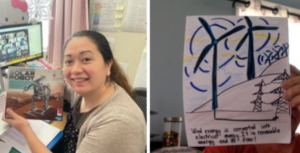 Green STEM Kits- Engage and Excite Students at home
Green STEM Kits- Engage and Excite Students at home
In 2020, USC’s Joint Educational Project (JEP) was awarded a grant from the North American Association for Environmental Education (NAAEE) to bring “Green STEM” education to students and teachers in the Los Angeles Unified School District (LAUSD). The Green STEM team developed upper elementary grade-level lesson plans with exciting hands-on activities to teach students about fossil fuel emissions (CO2), the greenhouse effect, and reducing their carbon footprints. Equipped with knowledge of how individuals can reduce their carbon footprints, students were going to design “greenification projects” to implement in their schools (e.g., composting, hydro/aquaponics systems, community gardens, etc.). “As a researcher who studies climate change, I am passionate about living sustainably,” remarked Kelly. “I am excited by the potential that green education for students could lead to a more green-minded generation interested in protecting our planet.”
As the global pandemic began and in-person school shut down, JEP, along with the rest of the world, scrambled to find ways to adapt. We revised our plan by hosting a professional development program to familiarize teachers with climate change and green education to build confidence in teaching these concepts to their students. Because we were unable to implement greenification projects, we sent teachers Green STEM Kits — fun gadgets powered by alternative energy that teachers used to demonstrate different types of alternative energy and how they can be used. The grow-a-maze kit demonstrated how sunlight fuels plant growth, which in turn absorbs atmospheric CO2 via photosynthesis. The windmill kit showed students that wind can be used to capture energy, as indicated by the windmill’s ability to power a small lightbulb. Lastly, the solar robot kit, equipped with a solar panel to capture energy from the sun, walked around when placed outside on a bright day!
Emma Case, a junior at USC and co-author of this article, developed additional lesson plans to supplement the use of these green STEM kits in virtual classrooms. As an Environmental Studies major, she enjoyed using her expertise to contribute to the project: “It was such a joy to be able to combine my passions to create these lesson plans. Ever since I was a kid, I’ve been super interested in and passionate about our planet and finding ways to protect it. When I got to college, this translated into pursuing a degree in Environmental Studies. To be able to share this passion with kids while also teaching them about issues that are so important to the future of our planet was very fulfilling, and I’m so glad I got to participate in this project.”
When teachers were surveyed prior to using the green STEM kits and lesson plans in their classrooms, 98% agreed that they felt concerned about the environment and that their students should also care about the environment, yet only 65% believed that their students were knowledgeable about environmental issues. Despite the perceived knowledge gap of their students, only 45% of teachers had taught any environmental curricula in their classrooms this school year. After using the kits, teachers reported that they felt these lessons helped increase their students’ knowledge about environmental issues: “My kids love growing plants and can’t wait until Earth day to celebrate the planet! Thank you for the fun learning growing experiments with GROW-A-Maze. It really teaches the power of nature and all we need to protect.” We hope that continued use of these kits and lessons for green STEM education will inspire the next generation of environmentally conscious students!